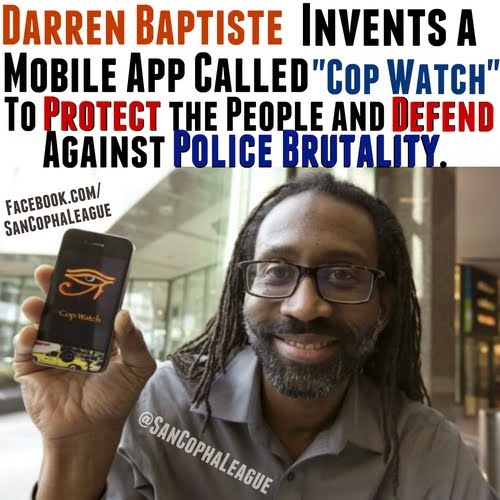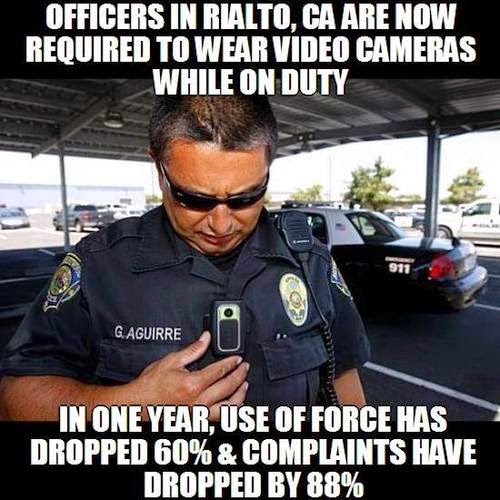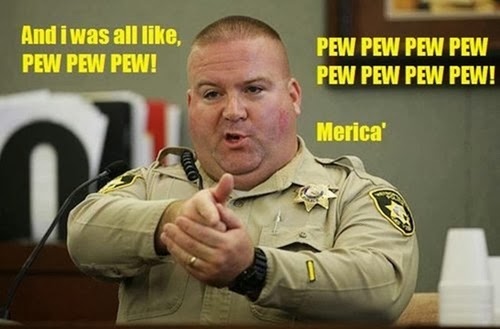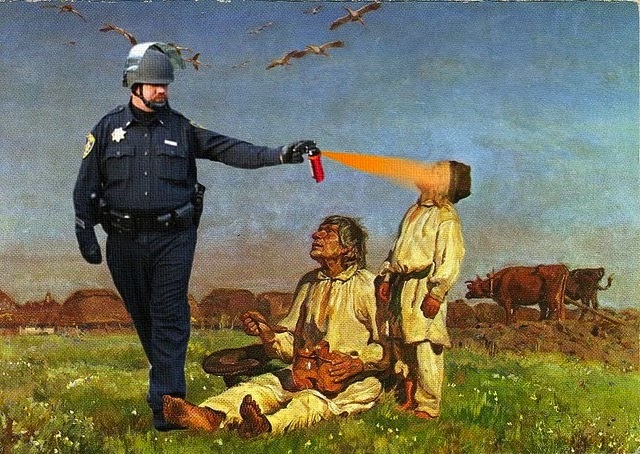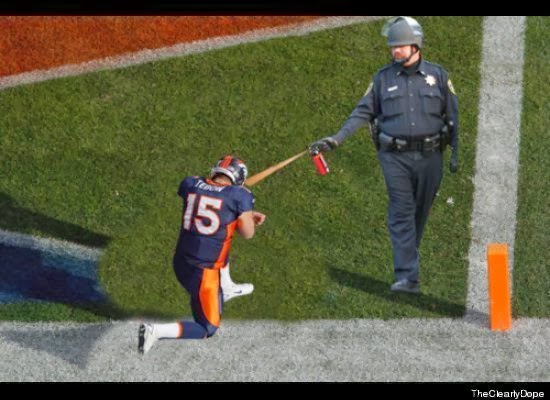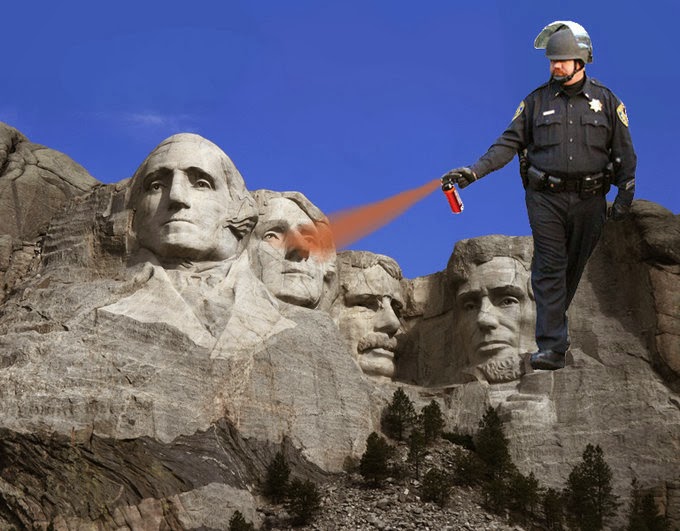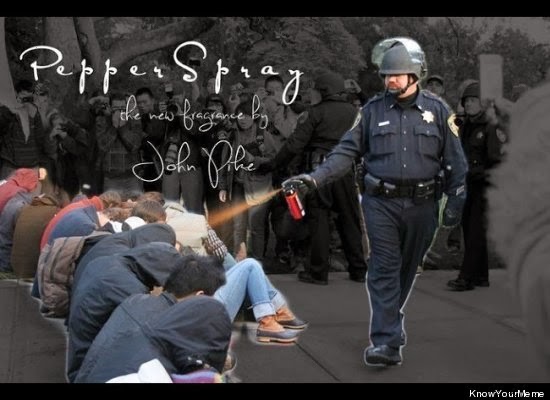Allegations Of Police Misconduct Rarely Result In Charges
By Reuben Fischer-Baum
Protesters block streets in St.
Louis, Missouri, after the announcement that a grand jury decided not to indict
Ferguson police officer Darren Wilson in the shooting death of 18-year-old
Michael Brown.
A St. Louis County grand jury
decided Monday that police officer Darren Wilson will not face trial for
shooting and killing unarmed teenager Michael Brown in Ferguson, Missouri.
Grand juries usually return indictments; the one exception is cases involving
police shootings. But more than that, police shootings, and allegations of
police misconduct in general, almost never make it in front of a grand jury.
And officers rarely face legal consequences for allegations of misconduct.
As is the case with police
shooting statistics, comprehensive numbers on accusations of police misconduct
are hard to come by. There is no national reporting requirement for such
accusations; in fact, many places have laws to purposefully keep the details of
misconduct investigations out of the public eye.
Nevertheless, two
nongovernmental sources stand out. A recent study out of Bowling Green State University
— reported by The Wall Street Journal — identified 664 incidents from 2005 to
2011 in which police officers were arrested for having “pulled, pointed, held,
or fired a gun and/or threatened someone with a gun.” These incidents resulted
in 98 deaths. The most common “serious offenses” associated with these
incidents are broken down below:
Of the 71 arrests for murder
and nonnegligent manslaughter, just 31 came when officers were on duty. That’s
about four a year during the study period. As a reminder, the best-available
evidence from the Killed By Police Facebook page points to about 1,000 deaths
each year caused by officers acting in the line of duty.
More general numbers on police
misconduct come from National Police Misconduct Reporting Project (NPMRP),
which collects data based on credible media reports (see its feed here). It was
established by researcher David Packman in 2009, and operation of the database
was transferred to the Cato Institute in spring 2012. Although the NPMRP
continues to collect incidents, the most comprehensive and cataloged data comes
from Packman’s original work. His key findings are largely laid out in a 2010
report.
In 2010, Packman identified
4,861 unique reports of police misconduct in the U.S. involving 6,613 officers.
Almost 10 out of every 1,000 American officers were accused of some type of
misconduct. For context, the 2010 violent crime rate was four crimes per 1,000
residents, and the larceny-theft rate was 20.1 per 1,000. Here’s a breakdown of
the accusations by type:
Excessive force was by far the
most common type of accusation, and 15 percent involved firearms. There were
127 excessive force incidents reported that resulted in fatalities, and the
majority of these (71 percent) were shootings.
But, as was the case with
Darren Wilson, most accusations of misconduct — combining all categories — did
not result in criminal charges. Of the more than 8,300 misconduct accusations
(involving almost 11,000 officers) in Packman’s database from April 2009
through the end of 2010, 3,238 resulted in legal action. The chart below
outlines how often these charges resulted in convictions and incarcerations,
compared with the rates for felony defendants in the general population (in the
75 largest U.S. counties) collected by the Bureau of Justice Statistics in
2006.
These numbers are now
irrelevant to Wilson. Outside of the unlikely event that federal charges are
pressed, his chance of being convicted and incarcerated for Brown’s death is
almost zero.
SF Public Defender’s Statement on Grand Jury Decision
San Francisco, CA — After
reviewing the transcripts and evidence released Tuesday, San Francisco Public
Defender Jeff Adachi released the following statement today on the grand jury’s
decision against indicting police officer Darren Wilson in the shooting death
of Michael Brown.
“As San Francisco Public
Defender, I am deeply disappointed with the grand jury’s failure to indict
Darren Wilson for the fatal shooting of unarmed teenager Michael Brown. A
series of questionable, and in my opinion, biased legal and ethical decisions
in the investigation and prosecution of the case presented to the grand jury
led to this unjust result, most notably allowing a local prosecutor with strong
family connections to police supervise the investigation and presentation of
the evidence. This ethical failure resulted in the exceedingly rare step of the
prosecuting attorney refusing to recommend an indictment against the police
officer he was prosecuting. The police
investigation and inquiry itself were rife with problems:
Because it was a grand jury
inquiry and not a trial, Wilson took the stand in secrecy and without benefit
of a cross-examination. Prosecutors not only failed to probe his incredible
testimony but frequently appeared to be bolstering his claim of self-defense.
Transcripts reveal that witnesses whose accounts contradicted Wilson’s were
rigorously questioned by prosecutors.
Dorian Johnson, the key witness
who was standing next to Brown during the encounter, provided strong testimony
that called into question Wilson’s claim that he was defending his life against
a deranged aggressor. Johnson testified that Wilson, enraged that the young men
did not obey his order to get on the sidewalk, threw his patrol car into
reverse. While Wilson claimed Brown prevented him from opening his door,
Johnson testified that the officer smacked them with the door after nearly
hitting the pair. Johnson described the ensuing struggle as Wilson attempting
to pull Brown through the car window by his neck and shirt, and Brown pulling
away. Johnson never saw Brown reach for Wilson’s gun or punch the officer.
Johnson testified that he watched a wounded Brown partially raise his hands and
say, “I don’t have a gun” before being fatally shot.
Wilson’s description of Brown
as a “demon” with superhuman strength and unremitting rage, and his description
of the neighborhood as “hostile,” illustrate implicit racial bias that taints
use-of-force decisions. These biases surely contribute to the fact that African
Americans are 21 times more likely to be shot by police than whites in the
U.S., but the statement’s racial implications remained unexamined.
Prosecutors never asked Wilson
why he did not attempt to drive away while Brown was allegedly reaching through
his vehicle window or to reconcile the contradiction between his claim that
Brown punched the left side of his face and the documented injuries which appear
on his right side.Wilson, who is 6 feet 4 inches tall and 210 pounds, is never
asked to explain why he “felt like a five-year-old holding on to Hulk Hogan”
during his struggle with Brown, who is Wilson’s height and 290 pounds.
The police investigation itself
revealed strong biases toward the police officer and against Michael Brown,
leading to an ongoing federal investigation into the police department’s
history of discriminatory policing practices, use of excessive force and
violations of detainees’ constitutional rights.
It is important that
communities throughout this country re-evaluate and reform our processes by
which justice is determined. We must work to ferret out biases that threaten
the very foundation of society and taint decisions rendered by our justice
system.
It is also critical that we
acknowledge the impact of implicit bias in decisions regarding stopping,
investigating, arresting and prosecuting citizens, and in gauging whether
deadly force is necessary. We must also demand that law enforcement agencies
begin using available technology, such as police body cameras, to improve
transparency and accountability to the public they are sworn to serve. And we
must pledge to honor the request of Michael Brown’s family to work together to
ensure that this tragedy is not repeated as it has been in the past.”
Video Shows NYPD Officer Striking Man in Head with a Nightstick for Attempting to Fare Beat
Video of an NYPD officer beating a young
man with a nightstick to his head for attempting to evade a subway fare was
posted online Friday.
Police confirmed, according to Gothamist,
that the footage shows an officer detaining 20-year-old Donovan Lawson after he
attempted to jump a turnstile at the Myrtle Avenue-Broadway in Brooklyn.
According to the police, the officer drew his nightstick and struck Lawson
after the man had resisted being put in handcuffs. The video, apparently
captured by a bystander with a cell phone, shows the officer strike Lawson
below his waist, then over his head, lacerating the young man's face.
Lawson is then seen trying to get away from
the officer, who aggressively grabs him, shoving him around the station
entrance. Gothamist reported that Lawson, was taken to Woodhull Hospital and
treated for cuts to his head, while the officer was taken to Wyckoff Heights
Medical Center and treated for injuries to his hand and arm.
Lawson has been charged with fare beating,
resisting arrest, disorderly conduct and obstructing government administration.
Meanwhile, the NYPD Internal Affairs department is reportedly investigating the
incident.
Dallas officer arrested by Child Abuse Squad
DALLAS — The Child Abuse Squad
has arrested a Dallas police officer on a charge of harassment, according to a
statement released by the Dallas Police Department.
Authorities announced the
arrest of Officer Casarae Womble early Friday afternoon.
Police didn't reveal any details
on the charge but said Womble was arrested by the Child Abuse Squad Friday.
A five-year veteran, Womble was
placed on administrative leave from the Metro Task Force as they investigate
the case.
Mills police officer gets probation for K9's death
ZACHARY MILLER PLEADS GUILTY TO
ANIMAL CRUELTY
A Mills police officer faces an
animal cruelty charge following the death of a police dog that he allegedly
left in a hot patrol car for sever… Read more
A Mills police officer received
six months' probation after pleading guilty to animal cruelty in connection
with the July death of a police dog.
Zachary Miller admitted last
Thursday to leaving K-9 Nyx in a hot patrol car for several hours, resulting in
the animal's death, according to documents filed Monday in Natrona County
Circuit Court.
A judge sentenced Miller to six
months in jail but suspended the time behind bars in favor of six months of
unsupervised probation.
Miller was ordered to pay
$3,000 in restitution to the town of Mills during his time on probation. He was
also required to complete 100 hours of community service at Metro Animal
Control.
The officer’s restitution will
be reduced to $2,200 if he completes the volunteer time.
Miller had pleaded not guilty
to misdemeanor animal cruelty. His case was set for trial Thursday.
The officer left the dog in his
patrol car for more than six hours on July 9 while the vehicle was parked
outside the police department, according to an investigator's affidavit. The
car was running, but the air conditioning was turned off and the windows were
up.
Miller was suspended with pay
for a week starting the day of Nyx’s death, Mills police chief Bryon Preciado
said. Miller returned to work following an internal department investigation.
The results of the
investigation are not being released by the police department.
The officer is back on active
duty and will remain with the department, Preciado said Wednesday.
The affidavit states that
Miller arrived at the police department at 5:30 a.m. He left shortly after to
respond to a call with the other officer working that day, Jake Bigelow. The
two returned to the police department with Nyx in the vehicle about 6 a.m.
The officers went inside the
department, leaving the dog in the car, and did not return until about 12:20
p.m. The outside temperature had risen from 53 to 86 degrees, according to the
affidavit.
Police dogs are allowed inside
the station, Preciado said.
Nyx was a 10-year-old black Lab
who had been with the department since 2006. Miller had been her handler for
the past two years, during which Nyx lived with his family and went on family
vacations.
The department’s K-9 program is
being suspended while policies are reviewed, Preciado said.
Local residents protested at
the Mills Police Department on Aug. 23, claiming that Natrona County
prosecutors should have charged Miller with a felony.
District Attorney Mike Blonigen
said in August that prosecutors could not bring more serious charges against
the officer because Miller showed no intent to kill the dog.
The Mills Police Department is
paying Jensen Art Studio to construct a bronze statue of Nyx, which will be
placed in front of the station.
The statue will be unveiled
during a public memorial service. Preciado said that service has not yet been
scheduled.
Miller was represented by
Casper defense attorney Craig Silva. Natrona County Assistant District Attorney
Trevor Schenk prosecuted the case.
2 Baton Rouge police officers, former officer charged with abuse of power regarding sex act
By Elizabeth Vowell
BATON ROUGE, LA (WAFB) -
Two Baton Rouge Police officers
and a former officer have been indicted on abuse of power charges related to a
sex act.
Isaac Bolden, Travis Wheeler,
and Emerson Jackson are accused of walking up to a woman and a man in a parked
car at Old Hammond Park earlier this year and forcing the man to leave. Bolden
then allegedly had the woman perform a sex act on him.
Police officials say Bolden
resigned months ago and the other officers are on leave.
"They're always going to
be bad apples in the group. My job as an administrator is to find those bad
apples and serve them with the discipline and whatever law they may have
broke," said Baton Rouge Police Chief Carl Dabadie.
A grand jury handed up charges
of abuse of power against all three Wednesday afternoon. District Attorney
Hillar Moore explained that charges related to sexual battery did not apply in
this case because of issues with consent.
“Based on our review of the law
and compared to the facts, the abuse of office was the most proper charge,"
said Moore.
As for Officers Wheeler and
Jackson, Chief Dabadie says they're off the streets for now.
"We are following all the
guidelines set forth by law and by state civil service law. We've placed them
on administrative leave at this point. They have no policing power at this
point. We set forth the civil service procedure for termination," said
Dabadie.
If convicted, the charges carry
up to five years in jail, with a one year minimum.
"To indict one of your
own, police officers, it's just not a good situation, but we have to do what's
right for everybody regardless of who they are," said Moore.
Bolden's attorney, John
DiGiulio, said his client will plead not-guilty. Wheeler's attorney, Harry
Daniels, said his client will also plead not-guilty and that Wheeler was
shocked by the indictment. It is unknown if Emerson has representation yet.
MAN TELLS COPS HE'S UPLOADING VIDEO OF THEM, GETS ARRESTED
Charged with resisting arrest
for being outside, unarmed, on own property
BOB UNRUH
Bob Unruh joined WND in 2006
after nearly three decades with the Associated Press, as well as several Upper
Midwest newspapers, where he covered everything from legislative battles and
sports to tornadoes and homicidal survivalists. He is also a photographer whose
scenic work has been used commercially.
The arrest of a man who videoed
police officers violently serving an arrest warrant across the street from his
home indicates Americans no longer are masters of their own country, contends a
leading constitutional lawyer.
“In fact, you’re not even the
servant – you’re the slave,” said John Whitehead, president of the Rutherford
Institute.
Rutherford is representing
Gresham, Oregon, resident Fred Marlow, 27, who is facing charges and fines of
up to $5,000 after his Sept. 2 arrest.
“Clearly, when police officers
cease to look and act like civil servants or peace officers but instead look
and act like soldiers occupying a hostile territory, it alters their perception
of ‘we the people.’ However, those who founded this country believed that we
were the masters and that those whose salaries we pay with our hard-earned tax
dollars are our servants,” Whitehead said.
“If daring to question,
challenge or even hesitate when a cop issues an order can get you charged with
resisting arrest or disorderly conduct, you’re not the master in a
master-servant relationship. If fact, you’re not even the servant,” he said.
Gresham officials did not
return a WND call requesting comment.
Marlow’s video shows what
happened:
In a description of the video
on YouTube, he said it was about 4 a.m. when the incident began.
“I was laying in my apartment
sleeping an[d] I heard multiple bombs blasting and glass breaking and my entire
apartment shook repeatedly. I grabbed my iPad and ran outside as fast as I
could to see what was going on. There were 5 or more tank/military trucks just
cruising through my neighborhood.”
“Read “Police State USA” and
find out what’s really going on across the nation.
He said he was “assaulted
multiple times, and I feel like it was Gresham police abuse, and my rights were
violated.”
Whitehead said his organization
decided to help when he discovered Marlow had been arrested, jailed and charged
with interfering and resisting arrest for videoing the SWAT team raid.
Marlow argued he was on his own
property, was not carrying a weapon and was not interfering.
He was threatened then arrested
when he told the officers the video of their actions was being uploaded to the
Internet.
The video reveals the officers
saying: “Go inside right now. You are interfering right now. You need to go
inside right now. It’s a lawful order.”
Marlow pointed out there was no
curfew, he was unarmed and he was on his own property.
The Rutherford Institute said
its first priority was to arrange legal counsel for Marlow.
San Jose poised to settle false imprisonment claim against police
By Tracey Kaplan
SAN JOSE -- Ammir Umar was
yanked out of his pre-calculus class at Evergreen Community College three years
ago on suspicion of selling people empty boxes stuffed with wood he claimed
contained TVs, and locked up for almost a month.
The 18-year-old faced more than
six years in prison on grand theft and other charges. But prosecutors released
Umar 29 days later and dropped the charges after he proved he'd been working at
Wal-Mart at the time and that the sworn affidavit by the lead investigator
contained misleading statements.
Now, the San Jose City Council
is poised Tuesday to approve paying Umar and his lawyers $190,000 to settle a
lawsuit he filed claiming those statements by Sgt. Craig Storlie led to his
false arrest and imprisonment.
"I hope this is a wake-up
call for SJPD," said Umar, 22, who now works at a car rental agency and
hopes to open a body shop someday. "I was terrified. I told them I had
nothing to do with it and they said, 'If you keep lying, you'll do more time.'
"
Storlie is currently one of the
two officers in charge of the Police Department's Internal Affairs unit, which
investigates allegations of misconduct against cops. He also is one of two
chief investigators in the rape-allegations case against officer Geoffrey
Graves.
A settlement is not an
admission of fault; in risky cases, the City Attorney's Office will advise
settling to reduce the city's financial exposure. As a result, Storlie's
connection to the Umar matter is not expected to have any effect on Graves'
case.
"We don't believe Storlie
was negligent and certainly not deceptive," City Attorney Rick Doyle said.
But the settlement comes after
U.S. District Judge Howard R. Lloyd denied the city's request to reject the
case for lack of merit rather than allowing it to proceed to trial. The judge
ruled that "a genuine dispute exists as to whether Storlie engaged in
judicial deception causing Umar to be arrested pursuant to an invalid warrant
and without probable cause."
San Jose has paid about $27.8
million in the past 10 fiscal years ending in July to settle lawsuits. Claims
against police account for about $18 million of that, or 65 percent, according
to the City Attorney's Office.
In his six-page order, the
judge laid out the series of events that led to the two misleading statements
in the affidavit. During the robbery, one of the thieves gave victims a phone
number he said they could use to reach him if they had any problems with the
purported TV. Storlie tracked the number to a man named Umar Well, who turns
out to be linked to paternity cases involving two children, including Ammir
Umar.
But Ammir Umar has had
virtually nothing to do with Well, who is his father, since Well left the
family when Umar was 5 years old. When Umar was 10, he and his younger sister
were put into foster care and eventually adopted because of his mother's mental
problems, he said.
Although the phone number was
linked to Umar Well, Storlie claimed in the sworn affidavit that it was
"registered" to Ammir Umar. Well, who is considerably older than the
robbers described by victims, is apparently known by several aliases, including
Amir Umar, which he spells differently than his son.
Then a photo lineup using five
DMV photos, including one of Ammir Umar -- but not of Umar Well -- was put
together. Storlie claimed in the affidavit that a witness positively identified
Ammir Umar by recognizing his smile.
However, the witness asserted
in a sworn declaration submitted in the lawsuit that he only said Umar's smile
resembled that of one of the suspects. The witness claimed he repeatedly told
Storlie and another unidentified officer that Ammir Umar was not the guy who
swindled him. He said the swindler's complexion was "much darker"
than Umar's.
Had that information been
included in the affidavit, the judge wrote, "A neutral magistrate may well
have not found that probable cause existed, and the warrant would not have
issued."
Blind Man: Cops Arrested & Ditched Me By Side Of The Road
Jim DeFede
MIAMI (CBSMiami) — On August
27th at approximately 8:30 pm, four plain clothes Miami Dade Police officers
pulled onto a dead end street in South Dade and arrested three young black men.
The scene was captured on video camera.
According to the police report,
the three men were arrested because officers claimed to see them passing what
appeared to be a marijuana cigarette. When the officers approached, they said
they found a marijuana cigarette on the ground near where the men were
standing.
They arrested the men for
possession of marijuana – a misdemeanor.
Two of the men were released on
the spot after signing tickets promising to appear in court.
The third man, Tannie “T-Man”
Burke wasn’t given that option. Instead police officers handcuffed him and led
him to the back of an unmarked car where he appeared to have trouble finding
the door.
“He’s blind dumb***,” the man
videotaping the incident is heard saying. “If you don’t tell him he’s walking
to the car how the (expletive) is he going to know?”
“T-Man what are they taking you
for?” a woman shouts.
“I don’t know,” Burke replies.
Blind since birth, the
21-year-old Burke can’t see anything out of his right eye, and is only able to
make out general shapes and lights with his left.
He’s able to navigate around
his block in the daytime but is afraid to wander too far at night.
“I’ve got to be with somebody,
or I’ve got to call somebody and have them meet me at this spot and I’ll walk
with them,” Burke told CBS4’s Jim DeFede.
For 20 minutes Burke estimates
the officers drove him around before finally releasing him in a dark and
desolate section of South Dade nearly a mile from his home.
“They put me off somewhere in
Goulds. There were no street lights and no houses,” he said. “It was just
dark.”
CBS4′s Jim DeFede asked, “Did
you tell the officers you were blind?”
“Yes I told them in the car I
was blind and I couldn’t see,” Burke said.
DeFede then asked, “Did they
seem to care?”
“Not that I know of,” he
answered. “They put me out somewhere where they aren’t no street lights and no
houses.”
Out on the edge of some vacant
farm land, they made him sign an arrest form he couldn’t read.
Burke said he asked them to
drop him off closer to his house, but they refused.
He had no cell phone. The
police had taken it.
DeFede asked, “Were you mad or
angry?”
“I was trying to get home.
That’s all it was. I was just trying to find my way home,” he said.
Unsure of where to go, Burke
started walking. He kept his right foot on the road and his left foot in the
weeds to prevent him from wandering into the middle of the street where he
might get hit by a car.
“I went down the street until I
found some light and I stayed on the same street going back and forth until
somebody came,” he said.
Eventually, he came upon a
stranger who helped him get home.
“Forty-five minutes to an hour
later he comes walking through the door all sweaty up,” said his stepfather,
Marvin Armstrong.
“I was like, `How’d you get
out?’ He said they released me way in the back,” Armstrong recalled.
Armstrong is Burke’s stepfather
and the man behind the camera filming Burke’s arrest and heaping insults on
officers.
Burke believes the police took
him away as payback for Armstrong’s actions. He said the cops complained about
him after they put him in the car.
“They said, `Your stepfather
got a lot of mouth. You know we don’t like that,’” he said.
Burke, who has never been
convicted of a crime, has been arrested twice and detained by police on more
than a dozen other occasions. Being stopped and handcuffed in his neighborhood,
he said, is nothing new.
“I feel they stop me because
they see a black man walking down the street,” he said. “I don’t know what to
say about it. I just feel bad about it. That’s it.”
Last month the misdemeanor
marijuana charges were dismissed by prosecutors.
Burke’s family filed a
complaint with the Miami Dade Police Department.
A Miami Dade Police spokesman
declined to comment on the way its officers treated Tannie Burke, saying the
case was now being investigated by the department’s Internal Affairs unit.
Woodville dog shot by police unlicensed
Medical expense donations for
dog close to $5,000 goal
BY ALEXANDRA MESTER
WOODVILLE, Ohio — The owners of
a dog shot by the Woodville police K-9 handler say the chocolate Labrador
retriever appears happy to be home, but is struggling with pain and may require
further hospital stays.
Lauren Bischoff said Friday
that 5-year-old Moses has not been able to sleep for more than a few minutes at
a time and whines in pain frequently despite strong medication.
“If it doesn't get better, we
might have to take him back,” she said.
Moses had surgery Wednesday at
West Suburban Animal Hospital in Sylvania Township to place rods and pins in
his right front foreleg. He went home Thursday.
Woodville K-9 Officer Steve
Gilkerson on Monday pulled a car over near the Bischoffs’ workplace at Lockport
Transportation, 875 E. Main St., just outside the village. Moses is a fixture
at the business, and he left the property and walked to the scene of the
traffic stop.
Officer Gilkerson, who kept his
K-9 partner in his cruiser, said Moses was targeted on him in an unfriendly way
and did not respond to being yelled at. Fearing for his safety and that of the
two people from the vehicle, who were also standing outside, he fired a single
shot at Moses.
The case has become a hotly
debated topic, as three witnesses claim Moses was not acting aggressively. The
dog also was not properly licensed at the time, nor was he restrained or under
an owner or handler’s reasonable control.
An online fund-raiser at
GoFundMe.com — “Justice for Moses” — is close to meeting a $5,000 goal. As of
this afternoon, nearly 140 people had donated more than $4,700.
“It’s amazing,” Mrs. Bischoff
said. “The generosity of the community is incredible. ... I wish I could thank
every one of these people individually.”
She said about 60 percent of
the people who have donated are people they don’t know. The top donor, who
chose to remain anonymous, sent in $345. Some have given just $10, others have
stopped by Lockport Transportation to drop off donations, including money and
homemade treats for Moses.
“Every little bit helps,” Mrs.
Bischoff said. “As far as our bills go, they’re up there.”
Mrs. Bischoff said Moses’
treatment and aftercare, particularly if he would be hospitalized again, may
exceed $5,000.
“I don’t see us having any extra
right now, but if we do, we wouldn’t pocket it,” Mrs. Bischoff said. “It would
go toward something, like a charity.”
Mrs. Bischoff and her husband,
Thomas, are getting Moses licensed. Mrs. Bischoff said they plan to file a
formal complaint with the police department next week, and she said the three
witnesses intend to do so as well soon.
Baltimore to create online database of police brutality lawsuits
By Luke Broadwater, Mark
Puente, The Baltimore Suncontact the reporters
George NilsonPublic
OfficialsAnthony BattsStephanie Rawlings-BlakeBaltimore Police Department
Sun investigation prompts city
to create police brutality database
Baltimore officials will begin
this month posting the outcomes of all civil lawsuits alleging police brutality
and will reconsider their policy of requiring plaintiffs to keep silent after
settlements are reached — part of a series of changes made in response to a
six-month Baltimore Sun investigation of police misconduct.
City Solicitor George Nilson,
who enacted the new policy regarding police settlements and court judgments,
said officials also would seek to provide increased training for officers who
are most often cited in lawsuits. The moves would give the public more
information about the lawsuits, he said Thursday, adding, "I want to end
the thinking that we're hiding the ball, because we're not."
Nilson said the moves were made
in response to The Sun investigation, which showed the city has paid about $5.7
million since 2011 over lawsuits alleging police brutality and other
misconduct. The U.S. Justice Department has since begun a review of the
Baltimore Police Department. The investigation revealed that police leaders,
city attorneys and other top officials were not keeping track of officers who
repeatedly faced such allegations. Meanwhile, judges or prosecutors cleared
nearly all of those alleging misconduct of criminal charges in the incidents
that led to the lawsuits with the highest payouts.
The Sun's investigation also
showed that city policies helped shield the scope and impact of alleged police
brutality from the public. For example, settlement agreements include a clause
that prohibits injured residents from making any public statement — or talking
to the news media — about the incidents.
After the investigation was
published, some members of the City Council said they weren't aware the problem
was so widespread.
Some prominent area defense
attorneys said Thursday that the nondisclosure clause included in settlement
agreements should be eliminated. Someone who violates that clause risks losing
part of the monetary settlement. Last month, for example, the city withheld
$31,500 from a woman who had posted online comments about an incident; that was
about half of her settlement.
A. Dwight Pettit, who
frequently represents plaintiffs in lawsuits against police officers, says it
appears the city is trying to be more transparent, but he questioned the
substance of the changes. The city needs to eliminate the nondisclosure
clauses, he said.
"That's a suppression of
First Amendment rights," he said. "I don't see any reason for that.
That's continued intimidation."
Bryan A. Levitt, who also has
represented plaintiffs in such lawsuits, agreed.
"That would be real
transparency in government," he said. "There is no reason to keep it
a secret. The only reason to do so is self-serving. It establishes a wall
between the public and public servants."
Nilson said the online
database, which will note the outcome of lawsuits as court decisions and
settlements are reached, will allow the public to have a fuller understanding
of how often the city wins or loses cases. The database will not include cases
already settled, but their outcomes will be available upon request, he added.
In about 70 percent of such
lawsuits, the city wins or settles for less than $10,000, he said.
"I'm proud of our record,
frankly," Nilson said. "I intend to make sure our wins are robustly
posted."
The database will contain
summaries of excessive-force lawsuits, similar to the information presented to
the Board of Estimates. Some have criticized those summaries because they often
omit accusations of police brutality, but city officials argue that many
allegations are unfounded.
The city spending panel,
controlled by the mayor, must approve all expenditures greater than $25,000.
The excessive-force database will include all cases, no matter the size of the
settlement, Nilson said.
As part of the new policy,
Nilson said, a representative of the Police Department will be invited to
attend meetings at which city lawyers discuss whether to settle a case, and
officers in need of further training will meet one-on-one with city lawyers.
One example of a
"teachable moment," he said, might be the case of an officer who
doesn't buckle in a suspect while being transported, then gets in an accident,
injuring the suspect. Or an officer who tries to move an injured man without
calling for medical help. City lawyers can offer advice on ways to avoid
lawsuits, he said.
Nilson said city lawyers would
also research nondisclosure clauses in other cities to see whether Baltimore's
policies are "fair and consistent with best practices."
Mayor Stephanie Rawlings-Blake
said she has pushed to make Baltimore's government more transparent since
taking office in 2010, including creating the Open Baltimore website, where
city salaries, liquor licenses, crime data and other sets of information are
routinely posted.
"I was really perplexed
that so many elected officials said they had no idea the city has been making
these settlements," Rawlings-Blake said. "I want to make sure the
public and elected officials have this information. Now there's no excuse for
not knowing."
The issue of police brutality
has been a prominent topic in the city recently.
On Monday, the City Council
overwhelmingly gave preliminary approval to a bill to require all of
Baltimore's nearly 3,000 police officers to wear body cameras — despite
arguments from the mayor's office that the bill is illegal.
City Councilman Warren Branch,
the lead sponsor of the two-page bill, said residents of his district
repeatedly asked him to have police wear the cameras to cut down on brutality.
As reasons for the proposed law, he has cited questions surrounding the
in-custody death last year of Tyrone West and a recent video showing an officer
repeatedly punching a suspect, among other cases.
In October, Rawlings-Blake and
Police Commissioner Anthony W. Batts presented a plan to reduce police
brutality, calling for increased staff in the Internal Affairs Division, which
handles allegations of misconduct, and giving Batts wider authority to quickly
punish rogue officers. The plan included the creation of a task force to study
the implementation of body cameras.
The Justice Department is in
the early stages of conducting its review of the department, an examination
made at the request of the mayor and police commissioner.
Obama’s AG pick could send signal on police misconduct cases
By ERIC TUCKER Associated Press
Washington - Loretta Lynch was
a federal prosecutor in New York City when she encountered an astonishing case
of police brutality: the broomstick sodomy of a Haitian immigrant in a precinct
bathroom.
The 1997 assault on Abner
Louima set off street protests, frayed race relations and led to one of the
most important federal civil rights cases of the past two decades - with Lynch
a key part of the team that prosecuted officers accused in the beating or of
covering it up.
President Barack Obama's
nomination of Lynch to be attorney general comes as the department she would
take over continues to investigate the police shooting of an unarmed black
18-year-old in Ferguson, Mo., and seems partly intended to convey the message
that police misconduct and civil rights will remain a principal focus even
after the departure of Eric Holder.
If confirmed by the Senate,
Lynch would be the first black woman in the job and would follow the first
black attorney general.
Lynch has overseen corruption,
terrorism and gang cases in her years as a federal prosecutor. But it's her
involvement some 15 years ago in the Louima prosecution that gave her
high-profile experience in step with a core priority of the department.
"It is certainly
significant that she has a personal history of involvement in prosecuting
police misconduct," said Samuel Bagenstos, the former No. 2 official in
the department's civil rights division. "Obviously that will be helpful,
and probably suggests that police misconduct cases will continue to be a
priority of the Lynch Justice Department just as they were with the Holder
Justice Department.
Lawyers say Obama likely
selected Lynch, 55, the U.S. attorney for the Eastern District of New York, on
the strength of a varied career and stature within the department.
"She has spent years in
the trenches as a prosecutor, aggressively fighting terrorism, financial fraud,
cybercrime, all while vigorously defending civil rights," Obama said in
introducing Lynch at the White House ceremony Saturday.
He said her prosecution of the
officers in the Louima case was "one of her proudest achievements."
But there's also no doubt that
selecting someone with civil rights experience could reaffirm the government's
commitment to that cause. That figures to be an especially important signal to
send as community members in Ferguson brace for the real prospect that state
and federal investigations into the shooting death of Michael Brown will close
without criminal charges, outcomes that could disillusion civil rights
activists and community members.
Holder has said he expects his
federal investigation to conclude before he resigns, but Lynch still would
inherit a civil rights probe into the practices of the entire Ferguson Police
Department.
That investigation is one of
roughly 20 that the Justice Department has initiated into troubled police
departments in the past five years, more than twice the number undertaken in
the five years before that. Those cases are part of a broader civil rights push
- challenging strict state voter identification laws and promoting changes in
how federal prosecutors negotiate sentences, among other efforts - likely to
help shape Holder's legacy.
Holder's supporters will expect
Lynch to continue that work, though her experience in two different stints as
U.S. attorney goes well beyond that.
Her office, which encompasses
Brooklyn, Queens, Long Island and Staten Island, won convictions in a thwarted
plot to bomb the city's subway system, successfully prosecuted a New York state
assemblyman caught accepting bribes in a sting operation and, more recently,
filed tax evasion charges against Republican Rep. Michael Grimm. She's also
worked closely with Justice Department leadership by heading a U.S. attorneys
committee that advises Holder on policy.
But it was the case of Louima,
tortured with a broken broomstick on a bathroom floor, that elevated her
profile as a trial attorney. In a Senate questionnaire for the job of U.S.
attorney, she placed the case second - behind only a sexual harassment matter
involving a city councilman - in a list of the most significant cases she
personally handled.
Brooklyn District Attorney
Kenneth Thompson, a trial team member, recalled how Lynch generously gave him -
a more junior prosecutor - the responsibility of delivering opening statements
in the case while she worked to craft the strategy and narrative that would be
presented to the jury.
During the first trial in 1999,
which ended with mixed verdicts, Lynch and the prosecution team hammered the
officers for hiding behind a "blue wall of silence."
"Don't let these
defendants push us back to the day when police officers could beat people with
impunity, and arrest people for no reason and lie about it to cover it
up," she told jurors.
Alan Vinegrad, who succeeded
Lynch as U.S. attorney for the Eastern District and worked alongside her on the
Louima case, recalled her as diligent and thorough prosecutor who made a
compelling final argument to the jury.
"She had to get up and
respond to all the arguments of five different lawyers made over a day about
why all their clients were not guilty of anything," Vinegrad said.
"She had to pretty quickly decide, "OK, what are the important
arguments. How do I respond to them persuasively?"'
Lynch was U.S. attorney from
1999 to 2001, as the Louima case slogged through the courts on appeals and new
trials. She left for private practice before being nominated in 2010, this time
by Obama, to run the office again.
Lynch, who grew up in
Greensboro, N.C., "rode on her father's shoulders to his church, where
students would meet to organize anti-segregation boycotts," Obama said.
"She was inspired by stories about her grandfather, a sharecropper in the
1930s, who helped folks in his community who got in trouble with the law and
had no recourse under the Jim Crow system."
The president said Lynch
"has spent her life fighting for fair and equal justice that is the
foundation of our democracy."
Collateral Damage: Police shooting dogs in line of duty
BUFFALO POLICE HAVE OPENED FIRE
ON 92 DOGS SINCE 2011, KILLING THE VAST MAJORITY OF THEM. IS IT TIME TO START
TRAINING?
Danny Spewak and Megan Blarr ,
WGRZ
Chapter One
Buffalo police have opened fire
on 92 dogs since 2011, killing the vast majority of them.
On June 3, 2013, an unfortunate
but familiar sequence of events unfolded.
The Buffalo Police Department
executed a search warrant at an apartment on Breckenridge Street on the city's
West Side, looking for drugs. Upon entry, officers encountered a dog, described
in this particular incident report as "an aggressive pit bull type."
One officer fired his shotgun three times. The dog died.
Cindy was two years old, not
even fifty pounds heavy. Adam Arroyo, an Iraq War veteran, adopted her when she
was only six months old.
"These animals,"
Arroyo said, "they become like part of your family."
That week, Buffalo Police
Commissioner Daniel Derenda launched an internal investigation into Cindy's
death, following accusations that his officers had accidentally raided the
wrong apartment and should never have confronted Cindy in the first place. The
case received major local media attention— one of the few dog-shooting cases to
make headlines in Western New York.
But these are not uncommon
scenarios. According to use of force reports requested by WGRZ-TV under the
Freedom of Information Law, Buffalo Police shot at 92 dogs from Jan. 1, 2011
through Sept. 2014. Seventy-three of those dogs died. Nineteen survived. In
comparison, Buffalo's numbers more than triple the amount of dog shooting
incidents involving police in Cincinnati, a municipality of similar size. The
New York City Police Department, the nation's largest force, reported killing
half as many dogs as the Buffalo Police Department in its two most recent
annual discharge reports.
"The numbers are what the
numbers are," Buffalo Police Chief of Detectives Dennis Richards said.
"Certainly, no officer takes any satisfaction in having to dispatch a
dog."
During the time period analyzed
by WGRZ-TV, one individual officer shot 26 dogs, killing nearly all of them. In
the years 2011 and 2012 alone, this officer killed as many dogs in the line of
duty as the entire NYPD.
The Buffalo Police Department
does not train specifically for canine encounters, according to Richards, even
though dozens of other police departments across the United States have
recently implemented new training procedures to deal with dogs. Unlike other
departments, officers in Buffalo do not use Tasers, spray or other tools to
contain animals in a non-lethal manner.
"It has not come to that
point in Buffalo," Richards said, "that we've implemented any of
those other techniques."
Chapter Two
Under departmental protocol,
Buffalo Police may legally use their firearms "if the officer or another
person is in the process of being attacked by an animal and is in imminent
danger." In the case of Cindy, police simply noted in their incident
report that the dog was "aggressive," a word which appears dozens of
times in the use of force records.
Many of the 92 shootings in
Buffalo occurred during high-intensity raids and search warrant executions,
which often involve split-second decisions and fast-paced pursuits of armed and
dangerous subjects. In some cases, these criminals train their dogs – usually
pit bulls -- to protect themselves and threaten law enforcement.
Sometimes, a police officer has
no choice but to fire his weapon.
"It's a small percentage
of the number of total search warrants executed or actions taken by
police," Richards said, noting the department responds to about 1,000
calls per day and has already carried out 357 search warrants this year.
Not every call involved a
search warrant. According to a November 2011 incident report, Buffalo Police
responded with a dogcontrol officer to an intersection on the East Side, where
two dogs had apparently killed another dog. When the police arrived, one of
those dogs charged an officer, at which point he fired a fatal shot.
In January 2011, two officers
opened fire on two large black dogs in the back lot of the police station after
they began to "bark and charge." The officers fired one shot each—
both missed. The dogs ran away. And in December 2012, an officer responded to a
call at a residence near Delaware Park, which claimed a man was preparing to
shoot a dog in the yard. When the officer arrived, the pit bull then "started
charging at the officer," prompting the officer to fire a round and kill
the dog.
Buffalo Police have shot an
average of 24 dogs per year since 2011, a pace of one dog roughly every two
weeks. Due to the lack of a national record-keeping system, however, it's
difficult to compare Buffalo's numbers to other municipalities.
Cincinnati Police provided
WGRZ-TV with a copy of its use of force records, which revealed officers had
shot 27 dogs from Jan. 1, 2011 through Sept. 2014.
The New York City Police
Department produces an annual discharge report, publishing its most recent
version in 2012. According to those reports, the NYPD shot 72 dogs in 2011 and
2012, but fewer than 30 percent of those cases (21) resulted in fatalities.
Buffalo Police – which has a fatality rate of 79 percent since 2011 in
officer-involved dog shootings – killed twice as many dogs as the NYPD in that
two-year span.
Of course, for every Cincinnati
and New York City, there are also cities like Milwaukee, where a lawsuit cited
by the Associated Press revealed the police department shot nearly 50 dogs per
year from 2000 to 2008. In Southwest Florida, the News-Press discovered 111
instances of dog shootings among multiple agencies between 2009 and 2012,
representing about 37 per year. According to the Chicago Tribune, Chicago
Police shot approximately 90 dogs per year between 2008 and 2013.
Dr. Randall Lockwood, a senior
vice president for the American Society for the Prevention of Cruelty to
Animals, has studied police dog shooting incidents in hundreds of
municipalities, dating back more than a decade.
"Your information from
Buffalo, unfortunately, isn't that unusual for some cities, particularly where
there hasn't been training," Lockwood said.
Although it's impossible to
create an official tally of nationwide dog shootings, it's apparent through
social media that these cases occur quite often. Using Facebook, dog owners can
often rally tens of thousands of supporters after police shoot their dogs,
which has helped lead to widespread departmental change in some instances. In
Colorado, for example, a string of officer-involved dog shootings collected
major media attention and, eventually, led to a new state law requiring police
officers to undergo canine training. Illinois passed a similar law last year,
and legislation has surfaced in several other states addressing dog shootings
by law enforcement.
Former police officer Jim
Osorio now trains law enforcement
Former police officer Jim
Osorio now trains law enforcement with live dogs to help prepare them for
canine encounters in the line of duty.
In Cleburne, Texas, the public
has rallied this fall for Justice for Maximus. A police body camera recorded an
officer shooting and killing Maximus the Pit Bull, which spurred an
investigation. In the midst of the public outcry, the department has enlisted
the help of Jim Osorio, a former police officer and one of the nation's most
renowned experts on police canine encounters.
Osorio, author of
"Surviving the Canine Encounter" and an instructor for Canine Encounters
Law Enforcement Training, will teach officers in Cleburne non-lethal methods
for controlling dogs in the line of duty. Using a live dog, he'll show officers
how to read dogs' facial expressions, how to approach dogs and how to use
spray, Tasers, batons or other tools to safely fend off a threat.
Osorio has traveled the country
to implement this same training. He said he's trained countless officers in
places like Ithaca, N.Y., Atlanta, Ga., Texas, Washington, Idaho, Indiana and
California.
"I felt the need that
police officers need better interaction with dogs on the street," Osorio
said, "other than just taking out a gun and shooting them."
Lockwood said it's time for
every department to get on board.
"Unfortunately, it usually
takes a high-profile incident, something that's gone viral, gone public, or a
lawsuit, to really have this taken seriously," Lockwood said. "But
that's changing. We're now seeing police departments who are looking at this
kind of training. Proactively, and pre-emptively, they recognize that it's an
important part of community-oriented policing."
Buffalo has not implemented
this training, according to Chief Richards.
"I don't know if that
would be a recommended course of action. Have you heard of that?" Richards
said. "No, I don't believe I've ever heard of using live animals to
illustrate how an officer should react."
Chapter Three
“The message would be just do
your investigation correctly, realize what you're doing, and maybe have animal
control or some type of non-lethal method to extract these dogs.”
Adam Arroyo was at work when
police raided his apartment last June. He claims he chained Cindy before he
left that morning.
When he returned home that
evening, he discovered bullet holes in his dry wall, not to mention the remnants
of Cindy's chain and toys. But he didn't find Cindy's body. After police killed
her, Animal Control immediately transported her to the animal shelter. From
there, Arroyo cremated her.
According to Arroyo, his
apartment complex has two units in the upper section. He believes police
intended to raid his neighbor's apartment, but instead barged through his door
and shot Cindy.
"We should not get the
wrong apartment. I can't justify getting the wrong apartment,"
Commissioner Derenda told reporters that week in a press conference. "We
are looking into what took place. If something took place that shouldn't have
taken place, then people will be held accountable."
More than a year later, the
Buffalo Police Department declined to provide WGRZ-TV with an update on the
internal investigation. Arroyo has since moved out of his apartment.
"How would they feel if
somebody ran into their house and did that to them?" Arroyo said.
"The message would be, just do your investigation correctly, realize what
you're doing, and maybe have animal control or some type of non-lethal method
to extract these dogs."
Chapter Four
On the early morning of July
29, 2014, Buffalo Police assisted on a raid in West Seneca. Same scenario:
executing a search warrant, digging for drugs.
"I pretty much heard the
two shots," said Ronnie Raiser III, who had just awoken in his bedroom
when the officers entered his home. "After the first shot, I heard the dog
squeal."
Two Buffalo police officers
shot and killed 15-month-old
Two Buffalo police officers
shot and killed 15-month-old Rocky during a raid in West Seneca last summer.
Rocky's owner, Ron, has since filed a complaint against the department.
During the raid, police killed
Raiser's one-year-old pit bull, Rocky. The department's incident report once
again described the dog as "aggressive."
Raiser has filed a formal
complaint with the Buffalo Police Department and the West Seneca Police
Department, alleging excessive force and civil rights violations. In the
complaint, Raiser claims the officers raided the home looking for Ecstasy.
Insead, he said officers only found a small stash of his roommate's marijuana.
"Not only did they not
find any of the items listed in the warrant," the complaint states,
"they shot and killed my 15-month-old dog Rocky."
Raiser plans to eventually file
a notice of claim.
"I bawled my eyes
out," Raiser said. "It's hard. It really is."
According to the use of force
reports obtained by 2 On Your Side, the same police officer involved in the
raid of Raiser's home also shot Arroyo's dog, Cindy, back in 2013. This is also
the same officer who, as previously mentioned, shot 26 dogs in a
three-and-a-half year span, more than any other officer in the department.
Richards explained that some
officers act as the lead for the entry team during raids, which could place
certain individuals in position to encounter aggressive dogs more often than
others.
"It's a very dangerous
job," Richards said, "and per capita, the amount of work that we do,
the amount of search warrants executed, the amount of calls answered by
individual officers, I think the numbers are what the numbers are."
Twenty-five of the 26 dogs shot
by this officer died. In fact, more than three-quarters of the dogs shot by
Buffalo Police died from their wounds. In Cincinnati and New York City, fewer
than half of the dog shootings resulted in death.
Richards said he couldn't
explain the high percentage of fatalities. In Cincinnati, the police
department's policy explicitly directs officers not to take head shots at dogs,
if possible.
Chapter Five
Chief Richards said the Buffalo
Police Department would consider using non-lethal tools to contain dogs, noting
that his department has researched other cities before for feedback.
"We're always willing to
look at other tools available and other technology available and other ways of
doing business," Richards said. "Tasers have come up in the past from
time to time – the use of Tasers – but I think they're still a controversial
topic."
In New York City, written
procedures direct officers to "attempt to prevent an animal attack using
non-lethal options, including batons and OC spray." The ASCPA considers
the NYPD a shining example of a progressive police department as it perains to
animal protocol.
"We have been involved in
training NYPD officers for many years," Lockwood said. "On a per
capita basis, New York is far lower in incidents than that of lot of other
cities."
For Buffalo, the department
will have to live with its own number: 92 dog shootings in three-and-a-half
years. Seventy-three fatalities.
"It's nothing to be happy
about when a dog has to be let go. But, again, we should stress that it's the
owners of those dogs. It's the drug dealer that is putting that dog in harm's
way," Richards said.
On June 3, 2013, the search
warrant of the Breckenridge apartment on the West Side yielded no drugs, Arroyo
said.
"Cindy was the first dog
that was mine… she was actually my dog. First dog ever, and she was a great
dog," Adam Arroyo said. "She was friendly. All the kids in the
neighborhood used to come up and pet her. She wasn't a threat, you know?"
Photojournalists Franco Ardito,
Scott May, Dave Harrington, Dooley O'Rourke, J.T. Messinger and Ben Read
contributed to this report.
Subscribe to:
Posts (Atom)



















